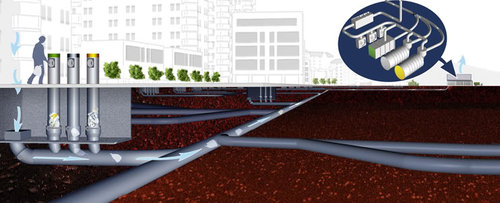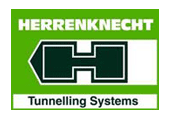

Nowadays, some cities are adopting underground pneumatic waste systems to transport and collect garbage without any surface activity.
The system consists of a fully enclosed vacuum system network, which means doing away with foul-smelling, dirty refuse collection rooms and containers in the streets.
Several cities all over the world are rapidly adopting these modern systems. The advantages are several, for modern cities but most of all for historical centers of older urban zones.
Nowadays, garbage is dumped in containers placed along public right-of-ways that, if collected daily by the municipal services, heavily deteriorate the city: garbage collection implies big trucks roaming old medieval roads and hence, badly damaging the local environment.
With the introduction of pneumatic garbage collection, old fashioned street containers have given way to modern boxes, and lorries no longer have to enter the city center, largely improving health, sanitation and overall environmental conditions.
The pneumatic underground system has a very complex but efficient operation system.
The waste is thrown into a normal inlet, either indoors or outdoors. Sorting at source is handled by using one inlet for each fraction.
These systems consist of a number of collection points, linked together by piping that transports the waste to a central collection station. When a refuse bag is deposited into an inlet, it is temporarily stored in a chute on top of a discharge valve.
All the full inlets connected to the collection station are automatically emptied at regular intervals. The control system switches on the fans and a vacuum is created in the network of pipes. An air inlet valve is opened to allow transport air to enter the system.
One by one, the discharge valves below each of the chutes are opened and the refuse bags fall down by gravity into the horizontal network of pipes and are sucked to the collection station.
The refuse enters the collection station via a cyclone that separates the refuse from the air. The refuse falls down into a compactor, which compacts the refuse in the sealed container. The transport air then passes through dust and deodorant filters and a silencer.
The system is ideal for separating waste for recycling, in which case there is an additional inlet and container for each category of refuse. The control system directs a diverter valve to convey each category of sorted waste into the correct container.
However, some disadvantages of pneumatic systems exist.
- High investment costs.
- Inconveniences are caused to inhabitants and businesses during the execution of construction works
- Possibility of blockages occurring in tubes and drop off points.
Some examples of cities where this system has already been adopted are the historical center of Leon, Zaragoza and Pamplona in Spain, or in Wembley, UK.
More info
Video











